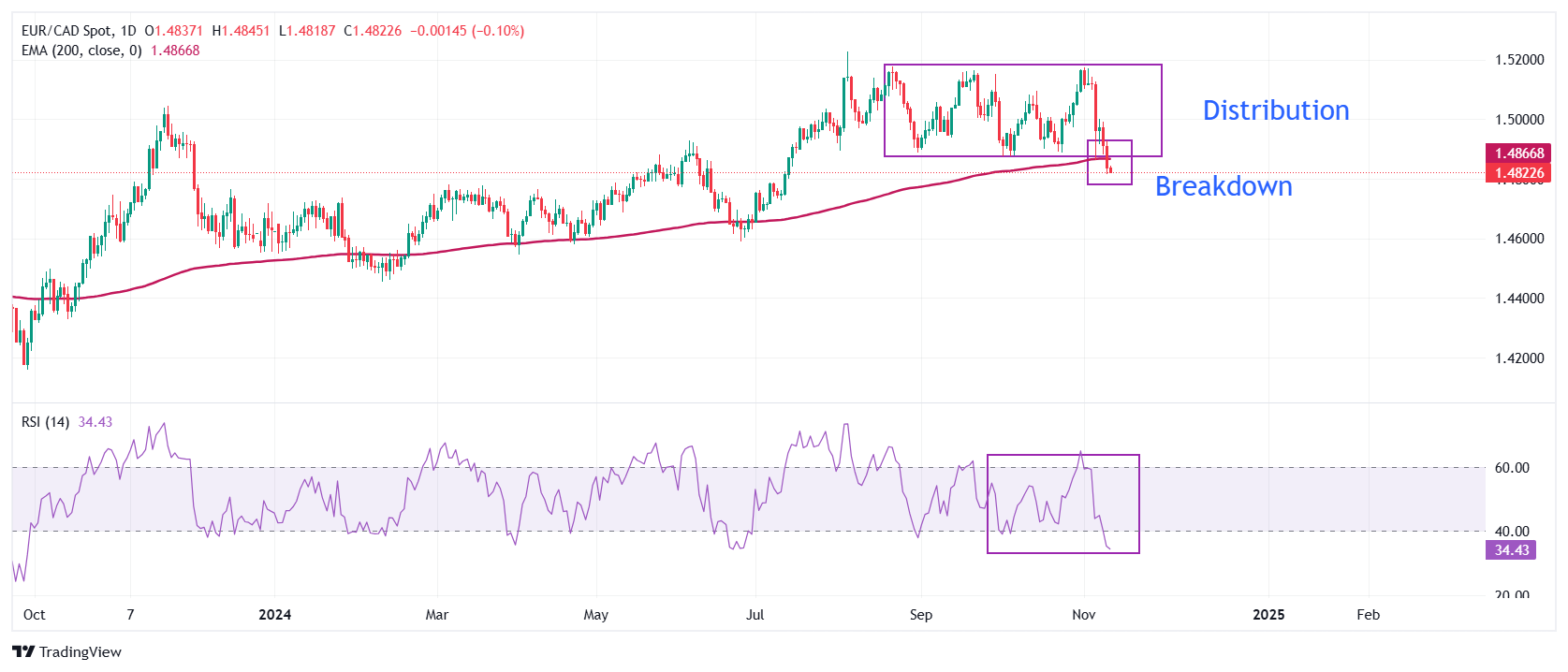- EUR/CAD weakens as the EURO faces selling pressure across the board.
- Trump’s victory and German political uncertainty have weighed on the Euro.
- The BoC is expected to cut interest rates by 50 bps next month.
The EUR/CAD pair trades close to more than a three-month low around 1.4820 in European trading hours on Tuesday. The cross extends its losing streak for the third trading day on Tuesday as the Euro (EUR) remains on the backfoot across the board.
The Euro faces intense selling pressure on Republican Donald Trump’s victory in United States (US) presidential elections who vowed to raise import tariffs by 10% universally in his election campaign. Though the impact should be seen on all trading partners of the US, the Euro appears to be a bigger victim, with Trump mentioning in his election campaign the euro bloc will "pay a big price" for not buying enough American exports.
Meanwhile, German political uncertainty after the collapse of the three-party coalition has also weighed on the Euro, challenging the economic growth by paving the way for a confidence vote on December 18 and a snap election on February 23, according to a report from Focus Online.
Though investors have underpinned the Canadian Dollar (CAD) against the US Dollar (USD), its outlook remains weak on growing expectations that the Bank of Canada (BoC) will cut interest rates further. The BoC is expected to reduce its key borrowing rates by 50 basis points (bps) again in the December meeting.
EUR/CAD delivers a breakdown of the Distribution formation on a daily timeframe in which the asset is transferred from institutional investors to retail participants, which results in a bearish reversal. The longer-term trend of the asset has also turned bearish as it has slipped below the 200-day Exponential Moving Average (EMA), which trades around 1.4866.
The 14-day Relative Strength Index (RSI) slides below 40.00, adds to evidence of more downside ahead.
The cross could decline to the July 10 low near 1.4730 and the round-level support of 1.4700 after breaking below the July 12 low near 1.4800.
On the flip side, a recovery move above the November 11 high of 1.4927 will drive the asset towards the psychological resistance of 1.5000 and the October 28 high of 1.5045.
EUR/CAD daily chart
Euro FAQs
The Euro is the currency for the 19 European Union countries that belong to the Eurozone. It is the second most heavily traded currency in the world behind the US Dollar. In 2022, it accounted for 31% of all foreign exchange transactions, with an average daily turnover of over $2.2 trillion a day. EUR/USD is the most heavily traded currency pair in the world, accounting for an estimated 30% off all transactions, followed by EUR/JPY (4%), EUR/GBP (3%) and EUR/AUD (2%).
The European Central Bank (ECB) in Frankfurt, Germany, is the reserve bank for the Eurozone. The ECB sets interest rates and manages monetary policy. The ECB’s primary mandate is to maintain price stability, which means either controlling inflation or stimulating growth. Its primary tool is the raising or lowering of interest rates. Relatively high interest rates – or the expectation of higher rates – will usually benefit the Euro and vice versa. The ECB Governing Council makes monetary policy decisions at meetings held eight times a year. Decisions are made by heads of the Eurozone national banks and six permanent members, including the President of the ECB, Christine Lagarde.
Eurozone inflation data, measured by the Harmonized Index of Consumer Prices (HICP), is an important econometric for the Euro. If inflation rises more than expected, especially if above the ECB’s 2% target, it obliges the ECB to raise interest rates to bring it back under control. Relatively high interest rates compared to its counterparts will usually benefit the Euro, as it makes the region more attractive as a place for global investors to park their money.
Data releases gauge the health of the economy and can impact on the Euro. Indicators such as GDP, Manufacturing and Services PMIs, employment, and consumer sentiment surveys can all influence the direction of the single currency. A strong economy is good for the Euro. Not only does it attract more foreign investment but it may encourage the ECB to put up interest rates, which will directly strengthen the Euro. Otherwise, if economic data is weak, the Euro is likely to fall. Economic data for the four largest economies in the euro area (Germany, France, Italy and Spain) are especially significant, as they account for 75% of the Eurozone’s economy.
Another significant data release for the Euro is the Trade Balance. This indicator measures the difference between what a country earns from its exports and what it spends on imports over a given period. If a country produces highly sought after exports then its currency will gain in value purely from the extra demand created from foreign buyers seeking to purchase these goods. Therefore, a positive net Trade Balance strengthens a currency and vice versa for a negative balance.
Information on these pages contains forward-looking statements that involve risks and uncertainties. Markets and instruments profiled on this page are for informational purposes only and should not in any way come across as a recommendation to buy or sell in these assets. You should do your own thorough research before making any investment decisions. FXStreet does not in any way guarantee that this information is free from mistakes, errors, or material misstatements. It also does not guarantee that this information is of a timely nature. Investing in Open Markets involves a great deal of risk, including the loss of all or a portion of your investment, as well as emotional distress. All risks, losses and costs associated with investing, including total loss of principal, are your responsibility. The views and opinions expressed in this article are those of the authors and do not necessarily reflect the official policy or position of FXStreet nor its advertisers. The author will not be held responsible for information that is found at the end of links posted on this page.
If not otherwise explicitly mentioned in the body of the article, at the time of writing, the author has no position in any stock mentioned in this article and no business relationship with any company mentioned. The author has not received compensation for writing this article, other than from FXStreet.
FXStreet and the author do not provide personalized recommendations. The author makes no representations as to the accuracy, completeness, or suitability of this information. FXStreet and the author will not be liable for any errors, omissions or any losses, injuries or damages arising from this information and its display or use. Errors and omissions excepted.
The author and FXStreet are not registered investment advisors and nothing in this article is intended to be investment advice.
Recommended content
Editors’ Picks

USD/JPY stalls the bounce below 150.50 after BoJ Ueda's speech
USD/JPY is stalling the rebound below 150.50 in the Asian session on Friday. Japan's core CPI rose to a 19-month high in January, reaffirming bets that the BoJ will continue to raise interest rates, underpin the Japanese Yen alongside BoJ Ueda's hawkish comments.

AUD/USD eases from over a two-month top, back below 0.6400
AUD/USD is trading back under 0.6400 early Friday, having briefly reclaimed 0.6400 for the first time since December 12 on Friday. Broad US Dollar rebound offsets RBA Governor Bullock's cautious stance on further easing, weighing negatively on the pair.

Gold down but not out ahead of US PMI data
Gold price is on a corrective move lower from near record highs of $2,955 set on Thursday. Despite the pullback, Gold price remains on track to book the eighth consecutive weekly gain.

Bitcoin underperforms as Gold, S&P 500 reach record high
Bitcoin traded above $98,000 on Thursday, continuing its range-bound movement, while traditional assets, including Gold and the S&P 500, set new highs. Meanwhile, asset manager VanEck noted that Bitcoin could help reduce the US national debt.

Money market outlook 2025: Trends and dynamics in the Eurozone, US, and UK
We delve into the world of money market funds. Distinct dynamics are at play in the US, eurozone, and UK. In the US, repo rates are more attractive, and bills are expected to appreciate. It's also worth noting that the Fed might cut rates more than anticipated, similar to the UK. In the eurozone, unsecured rates remain elevated.

The Best brokers to trade EUR/USD
SPONSORED Discover the top brokers for trading EUR/USD in 2025. Our list features brokers with competitive spreads, fast execution, and powerful platforms. Whether you're a beginner or an expert, find the right partner to navigate the dynamic Forex market.
